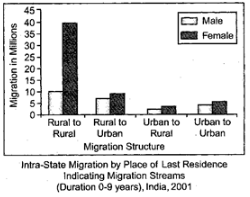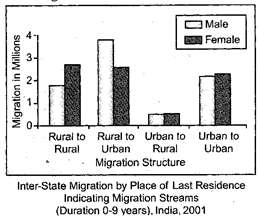Ch12 India Migration - Test Papers
CBSE Test Paper 01
Differentiate between life-time migrants and migrants by last residence.
Name two bases on which migration is enumerated on in the census of India.
State the problems that arise in urban areas due to migration.
Name the three states where the tribal population is more than three-fourths of the state population.
Why is work participation rate high among the scheduled tribes?
Which urban agglomeration of India has the highest share of migrant population? Why?
What do you mean by 'migration'?
Explain the three waves of Indian diaspora.
'Indian diaspora has been playing an important role in the development of the respective countries'. What are its implications on India?
Study the graphs give below and answer the following:


- In intra-state migration, which gender has the highest rate of migration and in which direction?
- In inter-state migration which gender has higher rate and in which direction?
- In which form migration seem equal amongst males and females?
CBSE Test Paper 01
Ch-12 India Migration
Answer
- The life-time migrant and migrant by the last residence are differentiated on the bases of birth-place and place of residence:
- If the place of birth is different from the place of enumeration it is called the lifetime migrant.
- if the place of the last residence is different from the place of enumeration it is known as migrant by place of last residence.
- Place of birth: It may be different from the place of enumeration (known as lifetime migrant).
- Place of residence: If it is different from the place of enumeration (known as migrant by place of last residence).
- Due to migration to urban areas, problems of slums, dirty colonies, and overcrowding take place. Due to excessive exploitation of natural resources, land degradation, air and water pollution, sewage problems, etc. arise.
- Following are the three states where the tribal population is more than three-fourths of their population:
- Meghalaya - 85.52%.
- Nagaland - 87.70%.
- Mizoram - 94.75%.
- The work participation rate is high among the scheduled tribes because:
- They live in very harsh conditions such as inaccessible, hilly and forested regions where they work a whole day to earn their bread.
- The tribal community is an open society where male, female and children enjoy equal status and participation in work.
- Working of females with males is not treated as a social stigma among the tribal communities. Hence the participation rate among tribal is high about half (49.7%) of tribals work to earn their livelihood.
- Greater Mumbai has the highest share of migrant population. It is due to following reasons:
- More employment opportunities.
- Urbanisation and industrialisation.
- Relatively higher wages.
- Better educational facilities.
- Other civic amenities.
- Due to different reasons when people move from one place to another either permanently or temporarily, it is called migration. Migration may be permanent, temporary or seasonal. It may take place from rural to rural, rural to urban, urban to urban and urban to rural. Migration is a spontaneous effort to attain a better balance between resources and population. There are push and pull factors working together behind migration.
- First wave: During colonial period, millions of the indentured labourers were sent to Mauritius, Caribbean islands, Fiji and south Africa by British from UP and Bihar to work as plantation workers.
- All such migrations were covered under the time-bound contract known as Girmit Act (Indian Emigration Act).
- The living conditions of these labourers were not better than the slaves.
- Second wave: It comprises Professionals, artisans, traders and factory workers emigrated in search of economic opportunities to Thailand, Malaysia, Singapore, Indonesia, Brunei and African countries.
- This led to the steady outflow of India's skilled and semi-skilled labour in the wake of the oil-boom in West Asia in 1970s.
- There was also some outflow of entrepreneurs, storeowners, professionals and businessmen to Western countries.
- Third wave:
- It comprises professionals like doctors, engineers, software engineers, management consultants, financial experts, media persons to countries such as USA, Canada, UK, Australia, New Zealand and Germany.
- These professionals enjoy the distinction of being highly educated, the highest earning and prospering groups.
- First wave: During colonial period, millions of the indentured labourers were sent to Mauritius, Caribbean islands, Fiji and south Africa by British from UP and Bihar to work as plantation workers.
- First wave: During colonial period, millions of the indentured labourers were sent to Mauritius, Caribbean islands, Fiji and South Africa by British from UP and Bihar to work as plantation workers. All such migrations were covered under the time bound contract known as Girmit Act (Indian Migration Act). The living conditions of these labourers were not better than the slaves.
- Second wave: The millions of professionals, artisans, traders and factory workers in search of economic opportunities migrated to Thailand, Malaysia, Singapore, Indonesia, Brunei and African countries, It led to steady outflow of India's skilled and semi-skilled labourers in the wake of oil-boom in West Asia in 1970s. There was also some outflow of entrepreneurs, store owners, professionals and businessmen to Western countries.
- Third wave: It comprises professionals like doctors, engineers, software engineers, management consultant, financial experts, media persons to countries such as the USA, Canada, UK, Australia, New Zealand and Germany. These professionals enjoy distinction of being highly educated and the highest earning and prospering groups.
- Brain-drain: The highly qualified and skilled people are moving out of the country leaving unskilled and illiterate stuff for domestic economy it has created scarcity of qualified manpower.
- Indian diaspora is playing an important role in the development of the countries of destination.
- In intra-state migration, the highest rate of migration has taken place amongst females.
- In inter-state migration, the highest rate of migration has taken place amongst males under rural to urban migration.
- Generally speaking, under Urban to Rural form, migration seems to be equal amongst males and females. These are the people who have emotional attachment to their native place and want to lead a peaceful life away from the noise of urban areas.
